Urban Projects and the Policy-Making Cycle: Indicators for Effective Governance
Abstract
1. Introduction
2. Indicators for Urban and Architectural Sustainability
3. Research Design
3.1. The Systematic Literature Review
3.2. Indicator Identification
- Provide an informed opinion on the relevance/importance and calculability of each individual indicator using a qualitative scale (high, medium, low, none, and unknown);
- Share their perspective on potential issues related to data availability for measuring the indicators (e.g., incomplete data, proprietary data, unreliable data, or data absence);
- Offer general positive or negative feedback for each indicator.
4. Results: Indicators’ Set Proposal
- Monitoring urban sustainability levels: Indicators useful for prioritizing intervention areas based on emerging issues (ex ante stage of evaluation—phase (i) of the policy-making cycle) or challenges and for observing and quantifying changes resulting from the implementation of specific urban and architectural projects (ex post stage of evaluation—phase (iv) of the policy-making cycle). For instance, if the “Outdoor Commons Space” indicator were to reveal, during the ex ante evaluation phase, a shortage of such spaces in a specific area, this would highlight the need for localized and targeted interventions to address the deficiency. Once this issue is acknowledged and incorporated into the project planning phase, subsequent ex post monitoring could, in the best-case scenario, demonstrate an improvement—thus validating the effectiveness of the implemented actions. Conversely, the monitoring may reveal either the deterioration or the persistence of the issue, indicating the need for further intervention or a reassessment of the strategies applied.
- Evaluating project sustainability: Indicators applicable to both district and building scales to assess the sustainability of projects before their implementation within the urban context (in itinere stage of evaluation—phase (ii) of the policy-making cycle). For example, if the “Outdoor Commons Spaces” indicator revealed low performance for the project(s) in this aspect, it would suggest that, prior to implementation, the project should be revised to better ensure social sustainability. Conversely, if the indicator showed good performance for the project(s) under analysis, it would indicate that adequate and satisfactory measures have been planned in terms of the provision of outdoor common spaces.
- 15 indicators were regarded as highly relevant and easily calculable;
- 15 indicators were considered as highly relevant but with average calculability;
- 4 indicators were considered as moderately relevant but easily calculable;
- 14 indicators were considered as moderately relevant and with average calculability;
- 9 indicators were finally considered as not relevant and/or difficult to calculate.
- Open outdoor spaces for interaction, housing cost overruns, energy efficiency and accessibility, for Target 11.1;
- Availability of bicycle lanes, pedestrian distances from transformation sites to public transport stations, maximum availability of parking and interchange spaces, for Target 11.2;
- Unused buildings and areas to be reclaimed, for Target 11.3;
- The quantification of the available cultural heritage and the inclusive accessibility of school buildings, for Target 11.4;
- Finally, the distribution of green spaces in the city for Target 11.7.
5. Discussions and Conclusions
Supplementary Materials
Author Contributions
Funding
Institutional Review Board Statement
Informed Consent Statement
Data Availability Statement
Conflicts of Interest
References
- Asian Development Bank and the United Nations Environment Programme (ADB and UN Environment Programme). Strengthening the Environmental Dimensions of the Sustainable Development Goals in Asia and the Pacific. Tool Compendium. 2019. Available online: https://www.adb.org/publications/environmental-dimensions-sdgs-tool-compendium (accessed on 19 July 2021).
- Mecca, B.; Gaballo, M.; Todella, E. Measuring and evaluating urban sustainability. Valori Valutazioni 2023, 32, 17–29. [Google Scholar]
- OECD. Implementing the OECD Recommendation on Policy Coherence for Sustainable Development: Guidance Note. 2021. Available online: https://alnap.org/documents/19459/pcsd-guidance-note-publication.pdf (accessed on 14 February 2022).
- OECD. Evaluation in Development Agencies. Better Aid. 2010. Available online: https://www.oecd.org/content/dam/oecd/en/publications/reports/2010/12/evaluation-in-development-agencies_g1g1199c/9789264094857-en.pdf (accessed on 15 November 2024).
- Thomas, V.; Chindarkar, N. Economic Evaluation of Sustainable Development. 2019. Available online: https://library.oapen.org/bitstream/id/2e243f93-6068-4ae0-b74e-93bf2497bdce/1006970.pdf (accessed on 14 February 2022).
- Baffo, I.; Leonardi, M.; Bossone, B.; Camarda, M.E.; D’Alberti, V.; Travaglioni, M. A decision support system for measuring and evaluating solutions for sustainable development. Sustain. Futures 2023, 5, 100109. [Google Scholar]
- World Bank. Innovation Policy Learning from Korea: The Case of Monitoring and Evaluation (M&E). 2024. Available online: https://documents1.worldbank.org/curated/en/099435005132470189/pdf/IDU108b015321579b14079183af1de18cf7459ba.pdf (accessed on 12 December 2024).
- Poveda, C.A.; Lipsett, M.G. A Review of Sustainability Assessment and Sustainability/Environmental Rating Systems and Credit Weighting Tools. J. Sustain. Dev. 2011, 4, 36–55. [Google Scholar]
- Bond, A.; Morrison-Saunders, A.; Pope, J. Sustainability assessment: The state of the art. Impact Assess. Proj. Apprais. 2012, 30, 53–62. [Google Scholar]
- Cohen, M. A Systematic Review of Urban Sustainability Assessment Literature. Sustainability 2017, 9, 2048. [Google Scholar] [CrossRef]
- Morano, P.; Tajani, F.; Di Liddo, F.; La Spina, I. The Evaluation in the Urban Projects Planning: A Logical-Deductive Model for the Definition of “Warning Areas” in the Esquilino District in the City of Rome (Italy). Smart Cities 2023, 6, 469–490. [Google Scholar]
- Boggia, A.; Cortina, C. Measuring sustainable development using a multi-criteria model: A case study. J. Environ. Manag. 2010, 91, 2301–2306. [Google Scholar]
- Hiremath, R.B.; Balachandra, P.; Kumar, B.; Bansode, S.S.; Murali, J. Indicator-based urban sustainability, A review. Energy Sustain. Dev. 2013, 17, 555–563. [Google Scholar]
- Kim, R.E. The Nexus between International Law and the Sustainable Development Goals. Rev. Eur. Comp. Int. Environ. Law 2016, 25, 15–26. [Google Scholar] [CrossRef]
- United Nations. General Assembly Global Indicator Framework for the Sustainable Development Goals and Targets of the 2030 Agenda for Sustainable Development. 2024. Available online: https://unstats.un.org/sdgs/indicators/Global-Indicator-Framework-after-2024-refinement-English.pdf (accessed on 12 December 2024).
- ISTAT. Rapporto SDGs Informazioni Statistiche per l’Agenda 2030 in Italia. 2024. Available online: https://www.istat.it/storage/rapporti-tematici/sdgs/2024/Rapporto-SDGs2024-Ebook.pdf (accessed on 6 December 2024).
- ISTAT. Metadata. 2024. Available online: https://www.istat.it/statistiche-per-temi/focus/benessere-e-sostenibilita/obiettivi-di-sviluppo-sostenibile/gli-indicatori-istat/ (accessed on 11 November 2024).
- Ministero Dell’Ambiente e della Tutela del Territorio e del Mare (MATTM). Strategia Nazionale per Lo Sviluppo Sostenibile. 2022. Available online: https://www.mase.gov.it/portale/documents/d/guest/snsvs_2022-pdf (accessed on 19 July 2021).
- European Commission. Circular Economy. Principles for Buildings Design. 2020. Available online: https://ec.europa.eu/docsroom/documents/39984 (accessed on 14 February 2022).
- Jann, W.; Wegrich, K. Theories of the Policy Cycle. In Handbook of Public Policy Analysis: Theory, Politics, and Methods, 1st ed.; Fischer, F., Miller, G.J., Eds.; Routledge: London, UK, 2007. [Google Scholar]
- PRISMA. 2020. Available online: https://www.prisma-statement.org/prisma-2020 (accessed on 15 November 2024).
- Page, M.J.; Moher, D.; Bossuyt, P.M.; Boutron, I.; Hoffmann, T.C.; Mulrow, C.D.; Shamseer, L.; Tetzlaff, J.M.; Akl, E.A.; Brennan, S.E.; et al. PRISMA 2020 explanation and elaboration: Updated guidance and exemplars for reporting systematic review. BMJ 2021, 372, 160. [Google Scholar]
- Dente, B.; Vecchi, G. La valutazione e il controllo strategico. In Valutare per Governare. Il Nuovo Sistema dei Controlli Nelle Pubbliche Amministrazioni; Azzone, G., Dente, B., Eds.; Etas: Milano, Italy, 1999. [Google Scholar]
- OECD. Core Set of Indicators of Environmental Performance Reviews, Environment Monographs N° 83, Parigi (OECD/GD (93)179). 1993. Available online: https://one.oecd.org/document/OCDE/GD(93)179/en/pdf (accessed on 19 July 2021).
- United Nations. New Urban Agenda. 2017. Available online: https://habitat3.org/wp-content/uploads/NUA-English.pdf (accessed on 6 December 2024).
- European Commission. Urban Agenda for the EU Multi-Level Governance in Action. 2019. Available online: https://ec.europa.eu/regional_policy/sources/brochure/urban_agenda_eu_en.pdf (accessed on 6 December 2024).
- Lami, I.M.; Abastante, F.; Gaballo, M.; Mecca, B.; Todella, E. Fostering sustainable cities through additional SDG11-related indicators. Valori Valutazioni 2023, 32, 45–61. [Google Scholar]
- Bossel, H. Indicators for Sustainable Development: Theory, Method, Applications; International Institute for Sustainable Development: Winnipeg, MB, Canada, 1999. [Google Scholar]
- Marchi, G.; Lenti, L. La Valutazione Nei Processi di Piano.Strumenti di Trasformazione Urbana; Angeli: Milano, Italy, 2003. [Google Scholar]
- Batty, M. Cities and complex systems: Scaling, interaction, networks, dynamics and urban morphologies. In Encyclopedia of Complexity and Systems Science; Meyers, R., Ed.; Springer: New York, NY, USA, 2009. [Google Scholar]
- Okraszewska, R.; Jamroz, K.; Michalski, L.; Żukowska, J.; Grzelec, K.; Birr, K. Analysing Ways to Achieve a New Urban Agenda-Based Sustainable Metropolitan Transport. Sustainability 2019, 11, 813. [Google Scholar] [CrossRef]
- Lami, I.M.; Abastante, F.; Mecca, B.; Todella, E. Maps and SDG11: A complex but possible relationship. Int. J. Sustain. Dev. Plan. 2024, 19, 1217–1237. [Google Scholar]
- Regione Piemonte Strategia per lo Sviluppo Sostenibile del Piemonte. 2022. Available online: https://www.regione.piemonte.it/web/sites/default/files/media/documenti/2022-07/srsvs_luglio_2022.pdf (accessed on 14 November 2024).
- Regione Campania Campania Sostenibile. Strategia Regionale per lo Sviluppo Sostenibile. 2023. Available online: https://europa.regione.campania.it/wp-content/uploads/2023/06/CAMPANIA-SOSTENIBILE_21-27_SRSvS_DEFF.pdf (accessed on 14 November 2024).
- Regione Sardegna Sardegna 2030. La Strategia della Regione Sardegna per lo Sviluppo Sostenibile. 2021. Available online: https://www.cittametropolitana.bo.it/agenda_sviluppo_sostenibile/Engine/RAServeFile.php/f/Sardegna_Strategia_Regionale_Sviluppo_Sostenibile_2021.pdf (accessed on 15 November 2024).
- Building Research Establishment Environmental Assessment Method (BREEAM). BREEAM Communities. Technical Manual. 2012. Available online: https://breeam.com/standards/technical-manuals-form (accessed on 13 November 2024).
- Building Research Establishment Environmental Assessment Method (BREEAM). BREEAM International New Construction. 2021. Available online: https://breeam.com/standards/technical-manuals-form (accessed on 13 November 2024).
- Abastante, F.; Gaballo, M.; Mecca, B. Adaptive Reuse and Sustainability Protocols in Italy: Relationship with Circular Economy. Sustainability 2021, 13, 8077. [Google Scholar] [CrossRef]
- Abastante, F.; Lami, I.M.; Gaballo, M. Pursuing the SDG11 targets: The role of the sustainability protocols. Sustainability 2021, 13, 3858. [Google Scholar] [CrossRef]
- Penza, M.; Abastante, F. ITACA Plus: A New Methodology to Support Urban Design. In INTERNATIONAL SYMPOSIUM: New Metropolitan Perspectives; Springer Nature: Cham, Switzerland, 2024; pp. 17–28. [Google Scholar]
- Istituto per l’innovazione e Trasparenza Degli Appalti e la Compatibilità Ambientale (ITACA). Sostenibilità Ambientale Nelle Costruzioni-Strumenti Operativi per la Valutazione della Sostenibilità-Edifici Residenziali. 2019. Available online: http://www.registroprotocolloitaca.org/protocollo.asp (accessed on 15 November 2024).
- Green Building Council. Manuale GBC QUARTIERI. Per Progettare, Realizzare E Riqualificare Aree e Quartieri Sostenibili. 2015. Available online: https://gbcitalia.org/gbc-quartieri/gbc-quartieri-documenti/ (accessed on 15 November 2024).
- Green Building Council. GBC Condomini. Riqualificazione, Conduzione e Manutenzione delle Residenze Condominiali Esistenti. 2022. Available online: https://gbcitalia.org/gbc-condomini/gbc-condomini-documenti/ (accessed on 15 November 2024).
- Green Building Council. Manuale GBC HOME. Progettare, Costruire e Ristrutturare Edifici Residenziali. 2022. Available online: https://gbcitalia.org/certificazione/gbc-home/gbc-home-documenti/ (accessed on 15 November 2024).
- Brisku, C.; Capone, G.; Ciferri, D.; De Leo, V.; Liccardi, S. PINQUA. Programma Innovativo Nazionale per la Qualità Dell’Abitare. Progetti e Prime Evidenze. 2022. Available online: https://www.mit.gov.it/nfsmitgov/files/media/notizia/2022-06/Report%20PINQuA.pdf (accessed on 15 November 2024).
- Regione Piemonte Piano Paesaggistico Regionale (PPR). 2021. Available online: https://www.regione.piemonte.it/web/temi/ambiente-territorio/paesaggio/piano-paesaggistico-regionale-ppr# (accessed on 11 November 2024).
- Ministero Dell’istruzione e del Merito Catalogo Dataset Edilizia Scolastica. 2021. Available online: https://dati.istruzione.it/opendata/opendata/catalogo/elements1/leaf/?datasetId=DS0156EDISUPBARARCSTA2021 (accessed on 12 November 2024).
- Martínez Chao, T.E. Analysis and representation of accessibility parameters of urban open spaces. Sustain. Mediterr. Constr. 2022, 14, 222–226. [Google Scholar]
- Battisti, F. SDGs and ESG Criteria in Housing: Defining Local Evaluation Criteria and Indicators for Verifying Project Sustainability Using Florence Metropolitan Area as a Case Study. Sustainability 2023, 15, 9372. [Google Scholar] [CrossRef]
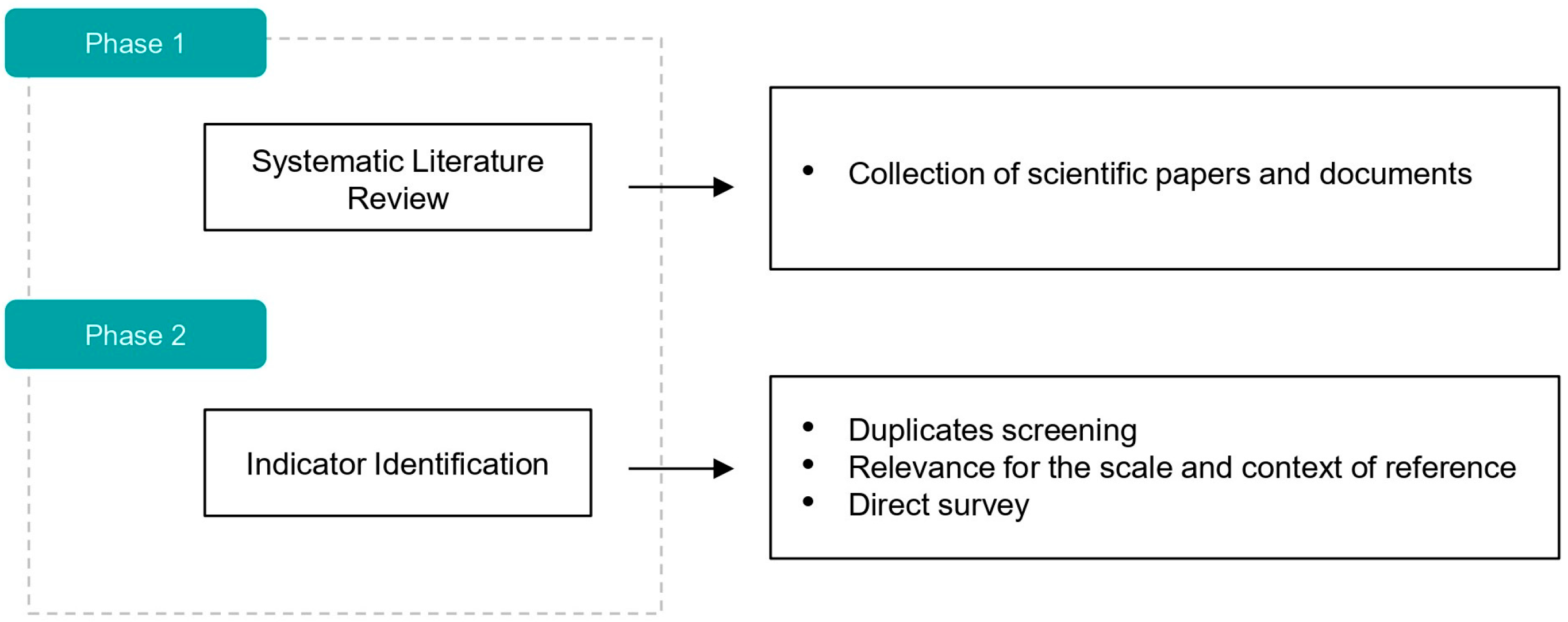
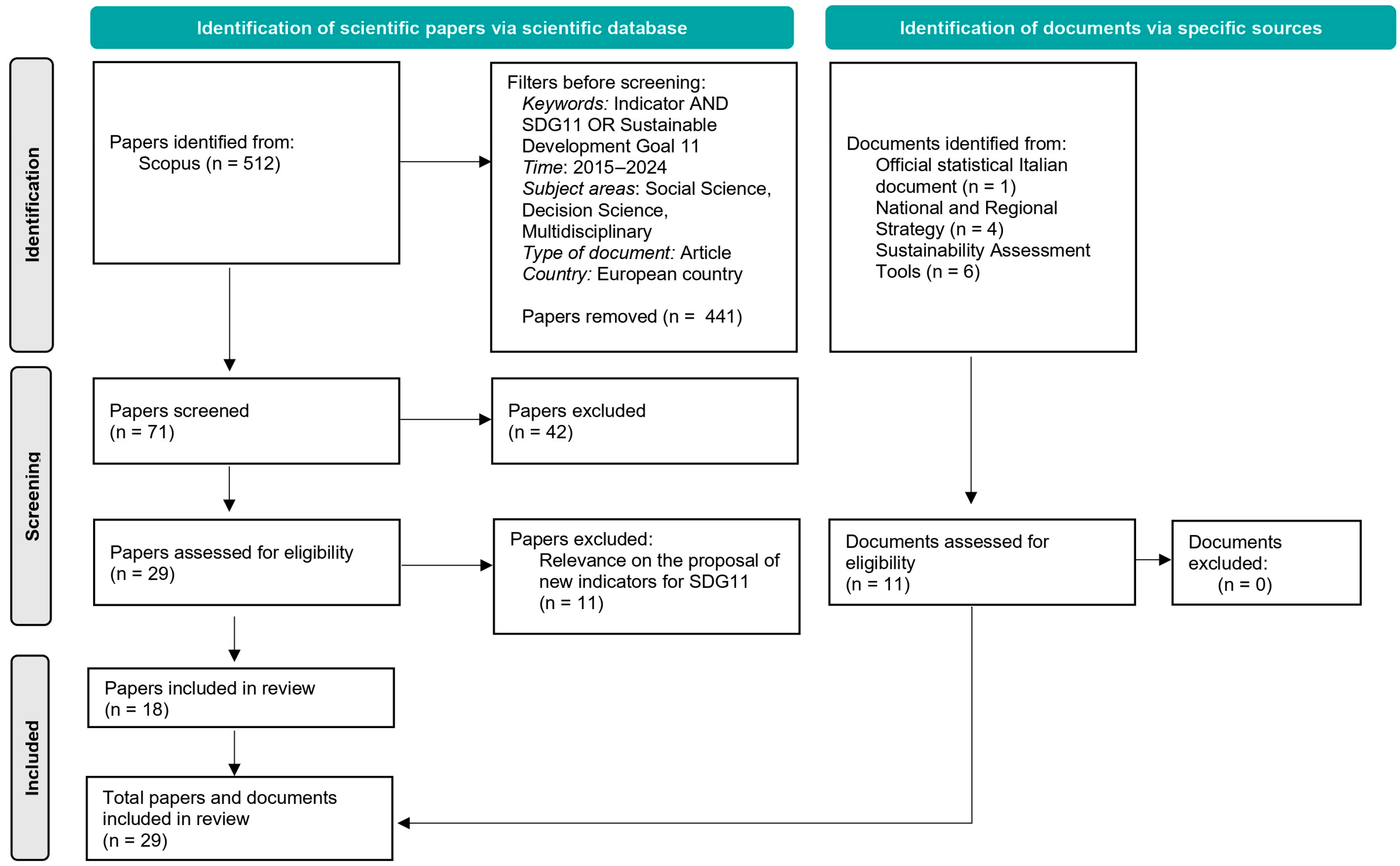
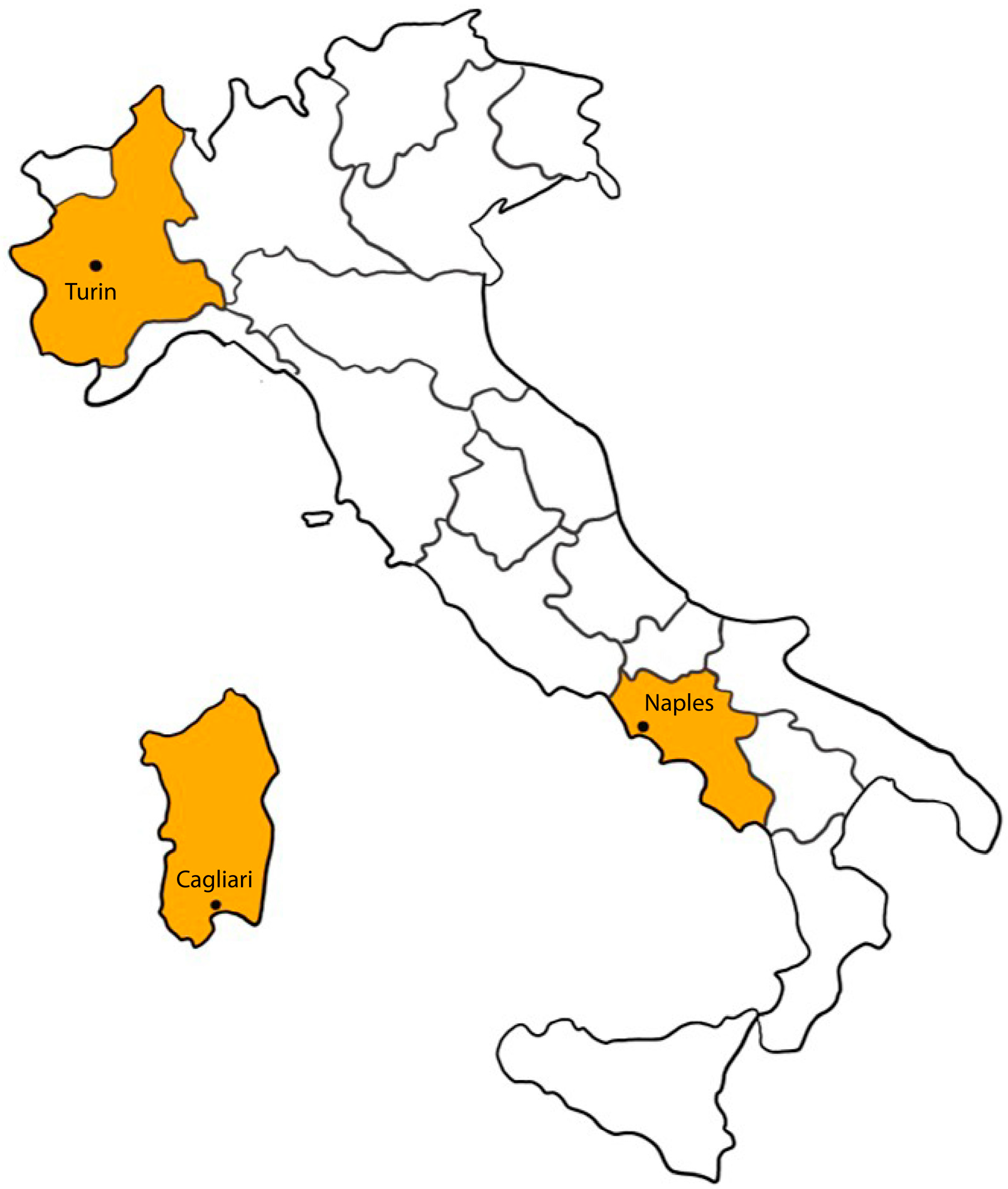
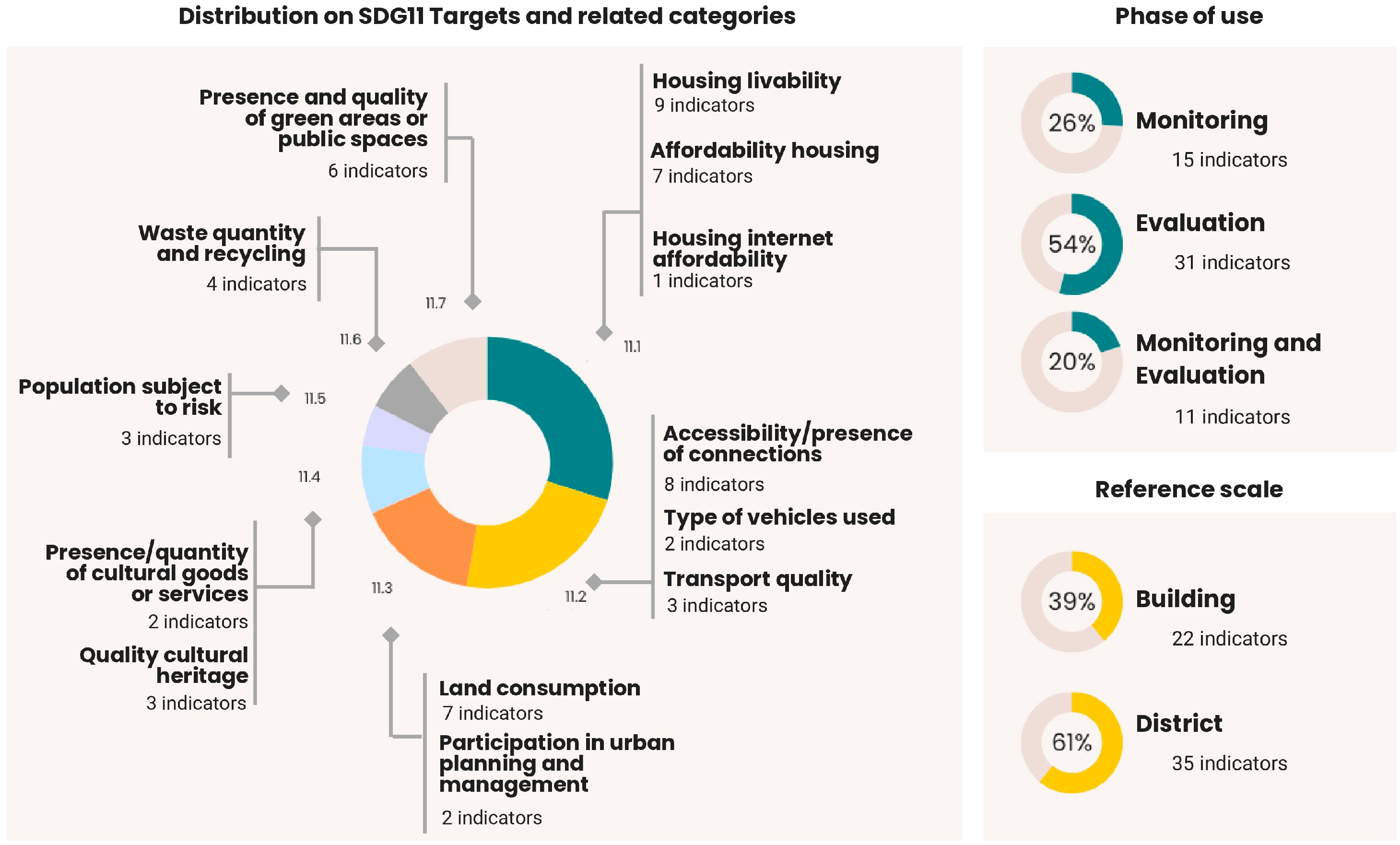
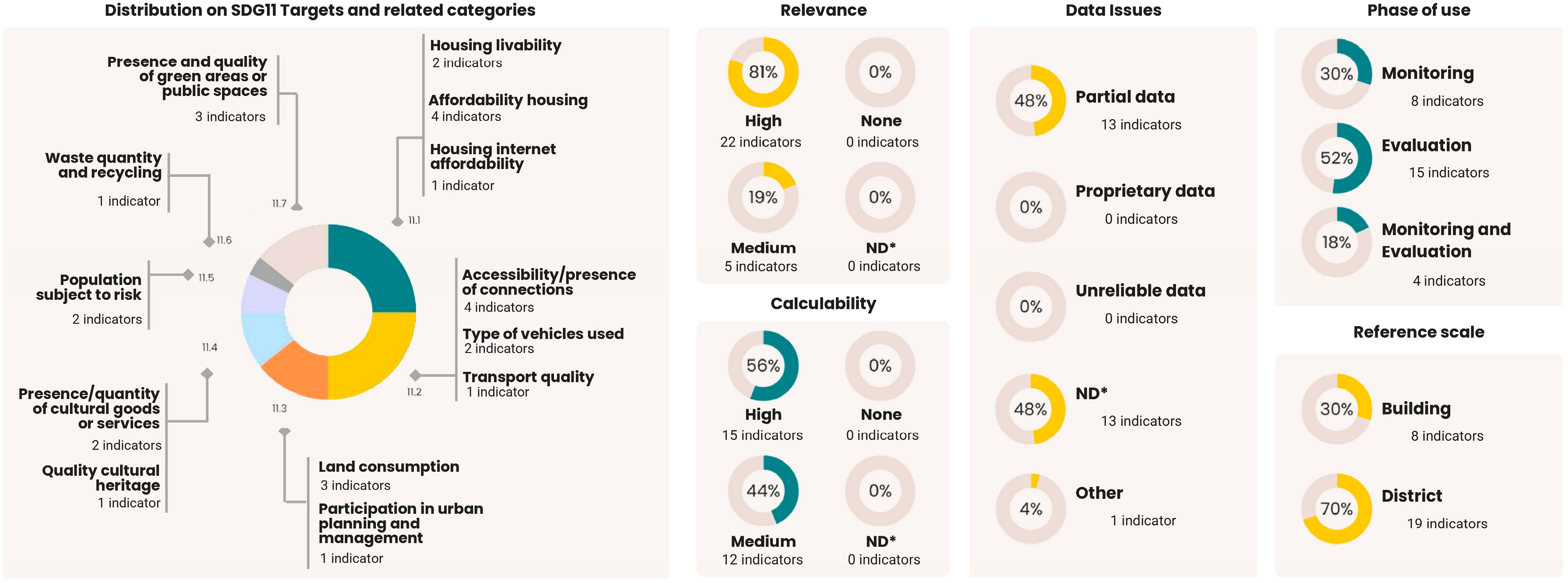
| Phase | Motivation of Exclusion | No. of Papers Excluded |
|---|---|---|
| Identification |
| 441 |
| Screening |
| 42 |
| Assessment for eligibility |
| 11 |
| Target | Category |
|---|---|
| Target 11.1. By 2030, ensure access for all to adequate, safe, and affordable housing and basic services and upgrade slums | Livability of dwellings |
| Housing affordability | |
| Housing internet affordability | |
| Target 11.2. By 2030, provide access to safe, affordable, accessible, and sustainable transport systems for all, improving road safety, notably by expanding public transport, with special attention to the needs of those in vulnerable situations, women, children, persons with disabilities, and older persons | Accessibility/presence of connections |
| Type of vehicles used | |
| Transport quality | |
| Target 11.3. By 2030, enhance inclusive and sustainable urbanization and capacity for participatory, integrated, and sustainable human settlement planning and management in all countries | Land consumption |
| Participation in urban planning and management | |
| Target 11.4. Strengthen efforts to protect and safeguard the world’s cultural and natural heritage | Presence of cultural goods or services |
| Expenditure on cultural goods or services | |
| Cultural heritage quality | |
| Target 11.5. By 2030, significantly reduce the number of deaths and the number of people affected, and substantially decrease the direct economic losses relative to global gross domestic product caused by disasters, including water-related disasters, with a focus on protecting the poor and people in vulnerable situations | Population subject to risk |
| Deaths or injuries from natural or road disasters | |
| Target 11.6. By 2030, reduce the adverse Per Capita environmental impact of cities, including by paying special attention to air quality and municipal and other waste management | Waste quantity and recycling |
| Emissions | |
| Target 11. 7. By 2030, provide universal access to safe, inclusive, and accessible green and public spaces, in particular for women and children, older persons, and persons with disabilities | Presence and quality of green areas or public spaces |
| Aggression and harassment |
| No. of indicators | ||||
| from LR | after DS | |||
| Target 11.1 | 73 | 43 | ||
| Category | No. of indicators | |||
| from LR | after DS | |||
| Livability of dwellings | 33 | 19 | ||
| Housing affordability | 26 | 13 | ||
| Housing internet affordability | 14 | 11 | ||
| Target 11.2 | 70 | 52 | ||
| Category | No. of indicators | |||
| from LR | after DS | |||
| Accessibility/presence of connections | 30 | 21 | ||
| Type of vehicles used | 20 | 15 | ||
| Transport quality | 20 | 16 | ||
| Target 11.3 | 33 | 20 | ||
| Category | No. of indicators | |||
| from LR | after DS | |||
| Land consumption | 24 | 12 | ||
| Participation in urban planning and management | 9 | 8 | ||
| Target 11.4 | 29 | 28 | ||
| Category | No. of indicators | |||
| from LR | after DS | |||
| Presence of cultural goods or services | 7 | 7 | ||
| Expenditure on cultural goods or services | 7 | 6 | ||
| Cultural heritage quality | 15 | 15 | ||
| Target 11.5 | 23 | 14 | ||
| Category | No. of indicators | |||
| from LR | after DS | |||
| Population subject to risk | 15 | 7 | ||
| Deaths or injuries from natural or road disasters | 8 | 7 | ||
| Target 11.6 | 95 | 71 | ||
| Category | No. of indicators | |||
| from LR | after DS | |||
| Waste quantity and recycling | 60 | 44 | ||
| Emissions | 35 | 27 | ||
| Target 11.7 | 18 | 16 | ||
| Category | No. of indicators | |||
| from LR | after DS | |||
| Presence and quality of green areas or public spaces | 14 | 12 | ||
| Aggression and harassment | 4 | 4 | ||
| Total | 341 | 244 | ||
| Category | Theme | Indicator | Description | Units of Measurements | Reference Scale | Phase of Use | References |
|---|---|---|---|---|---|---|---|
| Target 11.1 | |||||||
| Housing Livability | Overcrowding | Percentage of people living in overcrowded dwellings | The indicator measures the percentage of people living in overcrowded housing. | % | District | Monitoring | [16,17] |
| Housing Livability | Outdoor spaces | Common areas: interaction and common spaces | The indicator measures the endowment of multi-family buildings with outdoor common areas and spaces, which perform the function of “relationship spaces” owned and used by the entire building. | scenario- based | Building | Evaluation | [42] |
| Affordable housing | Cost | Housing cost overload | The indicator measures the percentage of people living in households where the total cost of running a home represents more than 40% of net household income. | % | District | Evaluation | [27] |
| Affordable housing | Cost | Housing types and social housing | The indicator measures housing and social housing types to promote a fair and supportive community, allowing a wide range of resident citizens belonging to different economic and social levels to live in the same community. | scenario- based | District | Evaluation | [46] |
| Affordable housing | Energy efficiency | Energy sustainability | The indicator assesses the number of plant types from renewable sources (none, +1 solar, +1 wind, +1 hydro, +1 geothermal, and +1 biomass) | Qualitative 0–5 | Building | Evaluation | [45] |
| Affordable housing | Energy efficiency | Energy efficiency | The indicator measures the number of increases in the energy classes of buildings. | Qualitative 0–5 | Building | Evaluation | [41] |
| Housing Internet affordability | Connections | Utility | The indicator assesses the provision of access to the site’s service infrastructure (gas, electricity, water, internet, etc.) and communication infrastructure—with minimal disruption and minimal need for reconstruction—and their readiness for future growth of services. | scenario- based | District | Evaluation | [36] |
| Target 11.2 | |||||||
| Accessibility/ presence of connections | Connections | Cycle paths | The indicator measures the increase or new construction of cycle paths. | m | District | Evaluation | [45] |
| Accessibility/ presence of connections | Connections | Public mobility | The indicator measures the pedestrian distance from the center of the intervention area to the nearest public transport hub. | m | District | Evaluation | [41] |
| Accessibility/ presence of connections | Connections | Households reporting difficulties with public transport connections in the area where they live | The indicator measures households that declare difficulties in connecting with public transport in the area in which they reside (for 100 households with the same characteristics). | % | District | Monitoring | [16,17] |
| Accessibility/ presence of connections | Connections | Accessibility to public transport | The indicator measures accessibility to public transport. | scenario- based | District | Monitoring | [41] |
| Type of vehicles used | Parking spaces | Supporting the use of bicycles | The indicator measures the percentage between the number of bicycles that can actually be parked in a functional and safe way and the number of users in the building. | % | Building | Evaluation | [37] |
| Type of vehicles used | Parking spaces | Maximum parking capacity | The indicator measures the amount of parking spaces according to the users of the building with a view to promote the use of alternative means of transport to and from the building as an alternative to the private car. In this sense, it is intended to help reduce transport-related emissions and traffic congestion associated with the operation of the building. | scenario- based | Building | Evaluation | [37] |
| Transport quality | Sustainable organization | Interchange points | The indicator assesses the design strategies regarding collective transport (comfortable and safe stops, guarantee of the construction of new stops within a predefined time, preparation of bicycle racks, etc.). in the proximity of the project. | scenario- based | District | Evaluation | [42] |
| Target 11.3 | |||||||
| Land consumption | Soil preservation | Soil sealing from artificial cover | The indicator measures the total amount of artificial cover land that exists at a given time. | % | District | Monitoring and Evaluation | [18] |
| Land consumption | Building reuse | Unused buildings by state of use | The indicator quantifies the number of empty buildings. According to the ISTAT glossary (2013), a building not in use is defined as a building/complex not yet ready to be used for residential purposes and/or for the production of goods or services because it is under construction; a building/complex no longer suitable for use for residential purposes and/or for the production of goods or services because it is falling down, in a state of disrepair, and similar. | n | District | Monitoring | [27] |
| Land consumption | Building reuse | Environmental reclamation | The indicator measures the surface area of the project subjected to environmental remediation, i.e., elimination of causes of pollution and hazardous materials present inside the buildings or in the areas subject to intervention. | m2 | Building | Evaluation | [45] |
| Participation in urban planning and management | Participation | Involvement and openness towards the community | The indicator evaluates strategies for raising awareness of the needs of the community by activating participation and involving the people who live within it in the design and planning of the intervention and in the decisions concerning the improvement or lasting change in their urban reality. | scenario- based | District | Evaluation | [42] |
| Target 11.4 | |||||||
| Presence/quality of cultural goods and services | Heritage | Cultural heritage and landscape assets | The indicator monitors the number of cultural and historical heritage assets and landscape assets. | n | District | Monitoring | [33,46] |
| Presence/quality of cultural goods and services | Building accessibility | Security for inclusiveness | The indicator quantifies the buildings equipped with specific measures for overcoming architectural barriers. | n | Building | Monitoring and Evaluation | [45] |
| Quality of cultural heritage | Inclusion | Buildings equipped with specific measures to overcome architectural barriers (meaning school buildings) | The indicator measures the number of cultural or non-profit associations involved in the project on the project’s covered area. | n/m2 | District | Evaluation | [33,47] |
| Target 11.5 | |||||||
| Population subject to risk | Environmental disasters | Population exposed to flood risk | The indicator measures the percentage of the population residing in areas with medium hydraulic hazard (return time 100–200 years pursuant to Legislative Decree 49/2010), identified on the basis of the ISPRA National Mosaic of Hydrogeological Plans (PAI, Italian acronym) and related updates, with reference to the P2 risk scenario. The population considered is that of the 2011 Census. | % | District | Monitoring | [16,17] |
| Population subject to risk | Environmental disasters | Population exposed to the risk of landslides | The indicator measures the percentage of the population residing in areas with high and very high landslide hazard, identified on the basis of the ISPRA National Mosaic of the Hydrogeological Plans (PAI, Italian acronymic) and related updates. The population considered is that of the 2011 Census. | % | District | Monitoring | [16,17] |
| Target 11.6 | |||||||
| Waste quality and recycling | Waste | Recycled/recovered materials | The indicator measures the percentage by weight of recycled and/or recovered materials used in the intervention in addition to the legal limit percentage. | % | Building | Evaluation | [41] |
| Target 11.7 | |||||||
| Presence and quality of green areas and public spaces | Green spaces | Distribution of green spaces | The indicator measures the distribution of spaces, in particular green areas in relation to the total study area and the number of inhabitants. | m2/ab | District | Monitoring and Evaluation | [48] |
| Presence and quality of green areas and public spaces | Green spaces | Green area | The indicator measures the ratio of vegetation area to mineral area. | m2/m2 | District | Monitoring and Evaluation | [45] |
| Presence and quality of green areas and public spaces | Degradation | Dissatisfaction with the landscape of the living place | The indicator measures the percentage of people aged 14 and over who declare that the landscape of the place of living is affected by evident degradation | % | District | Monitoring | [16,17,49] |
Disclaimer/Publisher’s Note: The statements, opinions and data contained in all publications are solely those of the individual author(s) and contributor(s) and not of MDPI and/or the editor(s). MDPI and/or the editor(s) disclaim responsibility for any injury to people or property resulting from any ideas, methods, instructions or products referred to in the content. |
© 2025 by the authors. Licensee MDPI, Basel, Switzerland. This article is an open access article distributed under the terms and conditions of the Creative Commons Attribution (CC BY) license (https://creativecommons.org/licenses/by/4.0/).
Share and Cite
Abastante, F.; Mecca, B. Urban Projects and the Policy-Making Cycle: Indicators for Effective Governance. Sustainability 2025, 17, 6305. https://doi.org/10.3390/su17146305
Abastante F, Mecca B. Urban Projects and the Policy-Making Cycle: Indicators for Effective Governance. Sustainability. 2025; 17(14):6305. https://doi.org/10.3390/su17146305
Chicago/Turabian StyleAbastante, Francesca, and Beatrice Mecca. 2025. "Urban Projects and the Policy-Making Cycle: Indicators for Effective Governance" Sustainability 17, no. 14: 6305. https://doi.org/10.3390/su17146305
APA StyleAbastante, F., & Mecca, B. (2025). Urban Projects and the Policy-Making Cycle: Indicators for Effective Governance. Sustainability, 17(14), 6305. https://doi.org/10.3390/su17146305







